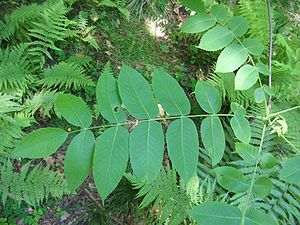Butternut
| Butternut | ||||||||||||
|---|---|---|---|---|---|---|---|---|---|---|---|---|

Unpinnate butternut leaf ( Juglans cinerea ) |
||||||||||||
| Systematics | ||||||||||||
|
||||||||||||
| Scientific name | ||||||||||||
| Juglans cinerea | ||||||||||||
| L. |
The butternut ( Juglans cinerea ), also Gray walnut , gray nut or white walnut called, is a plant from the genus of walnuts ( Juglans ) in the family of walnut family (Juglandaceae). It is native to North America and is used as an ornamental wood in some areas .
description
Appearance, bark and leaf
The butternut grows as a deciduous tree that reaches heights of 12 to 18 meters and a trunk diameter of 30 to 60 cm. The spreading crown is irregularly rounded with almost horizontally spreading branches. The trees grow quickly, but rarely get older than 75 years. The coarser, furrowed bark is ash to gray-brown.
The 3.5 to 12 cm long stalked leaves are 30 to 60 cm long and pinnate unpaired, with rarely seven, usually eleven to 17 leaflets . The leaflets are egg-shaped to lanceolate with differently hairy upper and lower sides. They are usually 5 to 11 (2.5 to 17.5) cm long and 1.5 to 6.5 cm wide, only the terminal leaflet is stalked, the others are sessile. The edge of the leaflet is serrated, the tip pointed to pointed. Young twigs and petioles are covered with sticky hair.
Inflorescence, flower and fruit
The flowering period extends from April to May. The butternut is single-sexed ( monoecious ). The male flowers are in cylindrical catkins 6 to 14 cm long . The male flowers contain 7 to 15 stamens . The pollen sacs are 0.8 to 1.2 mm in size. The female flowers have red, feathery stigmas .
Their ellipsoidal, partly pointed fruits, which are about 4 to 8 cm in size, are also sticky and hairy. The pitted, ribbed nuts are 3–6 cm long and egg-shaped. They contain a narrow, walnut-tasting and slightly oily core. The core shell is very hard with about eight irregular main furrows.
Chromosome number
The number of chromosomes is 2n = 32.
distribution
The home of the butternut is in eastern North America ; it extends north-south from New Brunswick in Canada over the eastern USA down to Georgia .
In Central Europe it can only be found practically in botanical gardens. Due to its frost resistance, its large and well-formed leaves and its beautiful autumn color, the butternut has become a very popular park and garden tree in Estonia , as it is too cold even in the cities for the purely outwardly similar tree of gods .
use
Butternut wood has a light red-brown core. It is relatively soft and not very resistant. It is often used for veneers, furnishings and interior trim. Wood is also valued in cabinet making.
The very small nuts are baked in cakes and biscuits. The taste of the butternut is slightly sweeter compared to the real walnut, but not as sweet as that of the even smaller Texan walnut ( Juglans microcarpa ). Butternuts are easier to crack than Texan walnuts. However, the edible core meat cannot easily be removed from the shell. The nuts ripen in September, so already relatively early. As with all walnuts, you should never pick nuts straight from the tree because they will be hollow. If you want to store the nuts, you have to peel them and dry them. Peeling the butternut is almost as tedious as cracking it and pulling its flesh out, because its shell is tough, sticky and almost rooted in the rough surface of the nut. It is also soaked in brown dye, which is difficult to remove from clothing and human skin.
In Massachusetts 120 years ago, the trunks of butternut trees were drilled and the sap that ran out was processed into sugar. The bark was used as a laxative. In your own garden you should be careful when tapping the trunk or cutting off branches, because like all walnuts the butternut tends to bleed to death in spring; the best time to prune the tree is in mid-August.
Like all walnuts, the butternut also produces a herbicide that is particularly harmful to apple trees, and unlike other walnut species, the roots of the butternut also grow in width. So caution is advised, even though the ground under butternuts is overgrown with grass, in contrast to the Manchurian walnut ( Juglans mandshurica ), for example.
An obstacle to the timber industry is that the trees cannot bear shade from above. If they grow in competition, they can get up to 10 meters higher.
Butternut trees are difficult to transplant because they quickly develop a taproot that they cannot survive damage.
swell
- Alan T. Whittemore & Donald E. Stone: Juglans in Flora of North America , Volume 3, 1997: Juglans cinerea - online (for section description).
Individual evidence
- ^ Erich Oberdorfer : Plant-sociological excursion flora for Germany and neighboring areas. 8th edition, Verlag Eugen Ulmer, Stuttgart 2001, ISBN 3-8001-3131-5 , p. 311.
- ↑ Juglans cinerea L. Noyer cendré (fr) ( Memento from December 15, 2010 in the Internet Archive ).
Web links
- Thomas Meyer: Data sheet with identification key and photos at Flora-de: Flora von Deutschland (old name of the website: Flowers in Swabia ).
- Forestry Institute at Virginia Tech: brief information on the nature and some pictures (engl.) ( Memento of 16 May 2009 at the Internet Archive )
- Forest Service of the US Department of Agriculture: Information on Art (Engl.)
- Virginia Tech factsheet with distribution area


